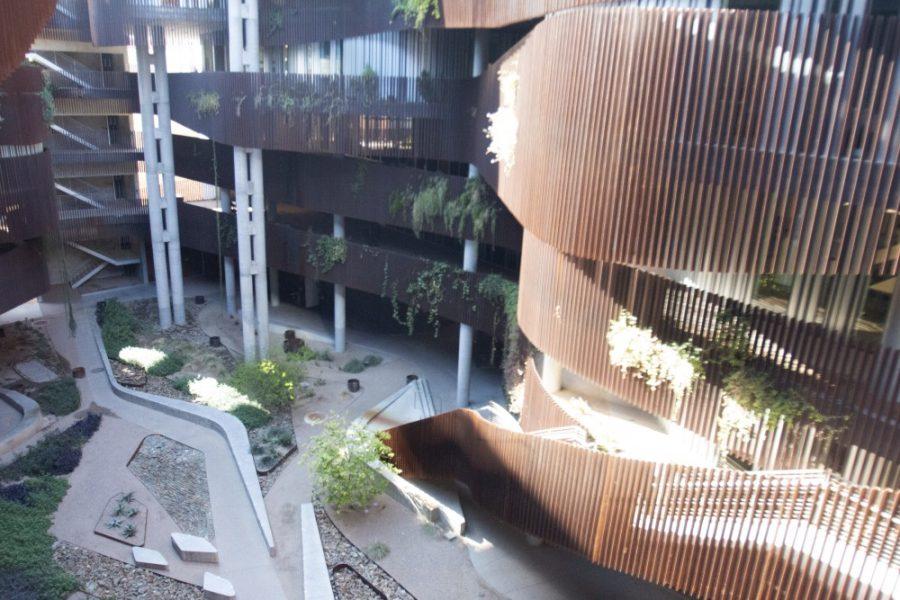The University of Arizona has been looking to lead in environmental initiatives for nearly a decade — this was why the Institute of the Environment was founded in the first place: as a communal space for environmental researchers to come together to find solutions to environmental challenges and to interact with communities so they can make the best-informed decisions and teach students to do the same.
According to Raina Maier, interim director of IE, there are several paths the world can take in the next few decades, and some of them lead to an unsustainable future with “higher temperatures, extreme weather, drought, food shortages and unrest”.
It is a “grim-looking fate,” but Maier said she sees potential for change through students.
“There are roads we can take that can mitigate some of those outcomes,” Maier said. “It is important for everyone to become educated so that we as a society make the decision to take a sustainable road.”
As climate change proves to be a polarizing economic and political issue, it is becoming more apparent that sustainability is interdisciplinary — not only within the scientific field, but within arts, humanities and business, Maier said.
“The sciences define the chemical, physical and biological laws that predict what is going to happen,” Maier said. “But unless we can communicate that to the public — through words, through art, through movement, through dance — people can’t appreciate the importance.”
Since taking on the role of interim director over a year ago, Maier has made it her mission to encourage environmental coursework for UA students across all disciplines.
RELATED: UA Poetry Centerites for criminal justice reform with arts grant
IE already provides the Green Degree Guide — a comprehensive list of all environmental and sustainability themed courses taught across the many platforms at the UA.
The Green Degree Guide exists to help students include a “green” concentration in their degree, although it may not show up on a diploma at this time. However, Maier said she sees “Green Degrees” becoming legitimate in the future.
The green concentration exists so students of any major can add sustainability classes to their resume.
In almost any discipline — be it design, economics, government policy, engineering — there is an aspect influenced by the environment, Maier said.
According to Maier, by learning key sustainability principles now, students can have a leg up in their future careers and play significant roles in spreading awareness in their field, which may not otherwise focus on environmentalism.
“Students will take those lessons to their next job and will be able to help their peers and supervisors understand why it is better to take a sustainable road, even if it looks more complex,” Maier said. “When these students take green courses, they get examples of how they can work in any industry and choose to be sustainable.”
Understanding governmental policy is important for having “an informed opinion and understanding of the climate initiative”, according to economics professor Stanley Reynolds, who teaches “Energy Markets and Environmental Economics”.
RELATED: Wildcats in New York
There are also considerable business opportunities arising from the unique obstacles climate change presents, Reynolds said.
Considering sustainability in optimizing business, industry and community is not only beneficial to the earth but to those involved.
“If we learn sustainability in conduction with other sciences and disciplines, if we teach students to consider the environmental impacts of their products, it will help students to design products better,” said Hongyue Jin, assistant professor of systems and industrial engineering and affiliated faculty of IE.
The arts, too, play a crucial role in communicating the message of environmental scientists and climatologists.
“The all-encompassing nature of the environmental challenges we face require the knowledge, perspective and skill sets of all disciplines,” said School of Art professor Ellen McMahon. “Art, design and the social and behavioral sciences are critical players in changing the way people think and act.”
McMahon, who teaches one of these “green” courses, titled “Art, Design and Environment,” said she teaches her students to bring their concerns about the environment out in their work because she believes understanding of climate change is sorely lacking in the art community.
“All students should take sustainability-themed courses to become more environmentally knowledgeable and responsible citizens,” McMahon said.
Maier’s current undertaking at IE is to augment the idea of the Green Degree Guide by making green concentrations more accessible and personalized for students and their unique interests.
Maier envisions a short quiz called find your path, about 10 questions, for students that helps them find a direction in environment and sustainability by leading them to majors, minors, clubs and activities that align with their interests.
“My vision is that students interested in the environment from all over the country, all over the world, will be able to come to the UA website, be directed to their perfect major — their perfect path — and see themselves making Arizona a home for their environmental education,” Maier said.
Right now, Maier is working on figuring out the right questions to ask and the best way to direct students. With more research and the help of web developers and a future team of undergraduates to give feedback on the exercise, Maier said she hopes to see “Find Your Path” go live by the end of the summer.
Because of the university’s unique set of departments, more than 300 world-class faculty members and an emphasis on interdisciplinary environmentalism, Maier said she believes the UA has the potential to become one of the foremost schools for environment and sustainability in the country.
“We have the faculty, we have the students and we have the chance to make our world better,” Maier said.
According to Maier, teaching students outside of the sciences about the environment is crucial to maintaining the planet and the quality of human life.
Follow the Daily Wildcat on Twitter









